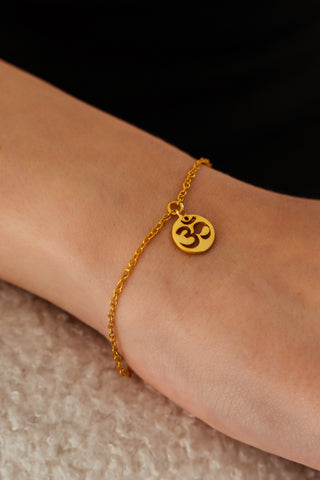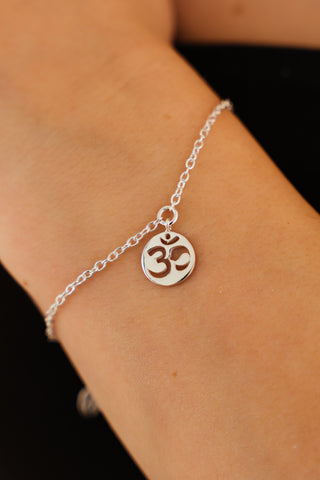Meaning, Vibrations, and Significance
Om (ॐ), also known as Aum, is one of the most profound and sacred symbols in Indian philosophy, Hinduism, Buddhism, and Jainism. It represents the essence of ultimate reality, consciousness, and the universe. Rooted in the Vedic tradition, the symbol and sound of Om are considered a primal vibration that resonates with creation itself. This essay will explore the significance of Om, beginning with its roots in the Vedas, moving to its metaphysical and vibrational impact on the human body and mind, and concluding with its cultural significance in contemporary fashion, jewelry, and talismans.
The Vedic Origins of Om
Om’s origins lie in the Vedas, the oldest scriptures of Indian spirituality and philosophy, composed around 1500-1000 BCE. It is prominently mentioned in the Upanishads, which are philosophical texts forming the basis of Hindu spiritual thought. The Mandukya Upanishad, dedicated entirely to Om, declares it as both the microcosm and macrocosm, encapsulating all that is manifest and unmanifest. According to this Upanishad:
“Om is this imperishable word. Om is the universe, and this is the exposition of Om. The past, the present, and the future—all that was, all that is, all that will be—is Om. Likewise, all else that may exist beyond the bounds of time is also Om.”
The syllable Om consists of three phonetic components—A, U, and M. These three sounds symbolize:
- A: Creation (Brahma), the waking state, or material reality.
- U: Preservation (Vishnu), the dream state, or the subtle world of thought.
- M: Dissolution (Shiva), the deep sleep state, or transcendence beyond thought.
The silence following the sound of Om represents Turiya, the fourth state of consciousness, a transcendental realm of pure bliss and unity. Together, these components embody the totality of existence.
The Vibrations of Om in the Body and Mind
The recitation of Om is not merely a spiritual exercise but also a profound experience of vibrational resonance. When chanted, the syllable Om produces vibrations that align with the frequencies of the body and the universe. Its sound and vibration are believed to harmonize the physical, mental, and spiritual planes of existence.
When Om is intoned, its vibrations pass through various parts of the body:
- “A” Sound: The “A” resonates in the lower abdomen, stimulating the root chakra (Muladhara) and the sacral chakra (Svadhisthana). It is associated with grounding and vitality.
- “U” Sound: The “U” resonates in the chest and throat area, activating the solar plexus chakra (Manipura) and heart chakra (Anahata). This enhances confidence, compassion, and emotional balance.
- “M” Sound: The “M” resonates in the head, stimulating the throat chakra (Vishuddha), third eye chakra (Ajna), and crown chakra (Sahasrara). This vibration fosters intuition, higher understanding, and a connection to divine energy.
The rhythmic chant of Om calms the mind, reducing stress and anxiety. It helps lower blood pressure, improves concentration, and induces a meditative state. Neuroscientific studies reveal that chanting Om activates the parasympathetic nervous system, which promotes relaxation and healing. The sound waves produced during the chant are thought to synchronize with the brain’s alpha waves, associated with a calm and meditative state.
Modern science aligns with ancient Vedic knowledge regarding vibration and sound as the fundamental building blocks of the universe. The quantum theory of the universe as vibrating strings resonates with the concept of Om as the “sound of creation.” Chanting Om creates a vibratory connection between the individual and the cosmos, fostering a sense of unity.
The Spiritual and Symbolic Significance of Om
The visual representation of Om (ॐ) is rich in symbolism. Each curve and point in the symbol corresponds to different states of consciousness:
-
The large lower curve: The waking state (Jagrat).
-
The middle curve: The dream state (Svapna).
-
The upper curve: The deep sleep state (Sushupti).
-
The dot: The transcendental state (Turiya).
-
The semicircle: Maya, the illusion that separates the higher self from realization.
This symbolism reminds practitioners of their spiritual journey toward unity with the divine, transcending the illusions of the material world.
Om’s Popularity in Fashion
Over the years, the Om symbol has transcended its spiritual roots to become a popular cultural and fashion icon. Its universal message of peace, unity, and spirituality has resonated with people across the globe, regardless of religious or cultural background.
Om has become a motif in clothing, tattoos, and home decor, symbolizing mindfulness and a connection to the greater whole. Its simplicity and aesthetic appeal make it a favored design for contemporary lifestyles
Om in Jewelry
Om design have gained immense popularity for the following reasons:
- Aesthetic Appeal: The elegant curves of the Om symbol make it a visually pleasing design that can blend with both traditional and modern styles.
- Spiritual Connection: Wearing Om jewelry serves as a personal talisman, reminding the wearer of their spiritual journey and inner peace.
- Cultural Appreciation: Many people wear Om jewelry as a mark of respect and appreciation for Eastern philosophies and cultures.
- Universal Message: In a world increasingly seeking peace and mindfulness, the Om symbol is a beacon of hope, transcending barriers of religion and geography.

























